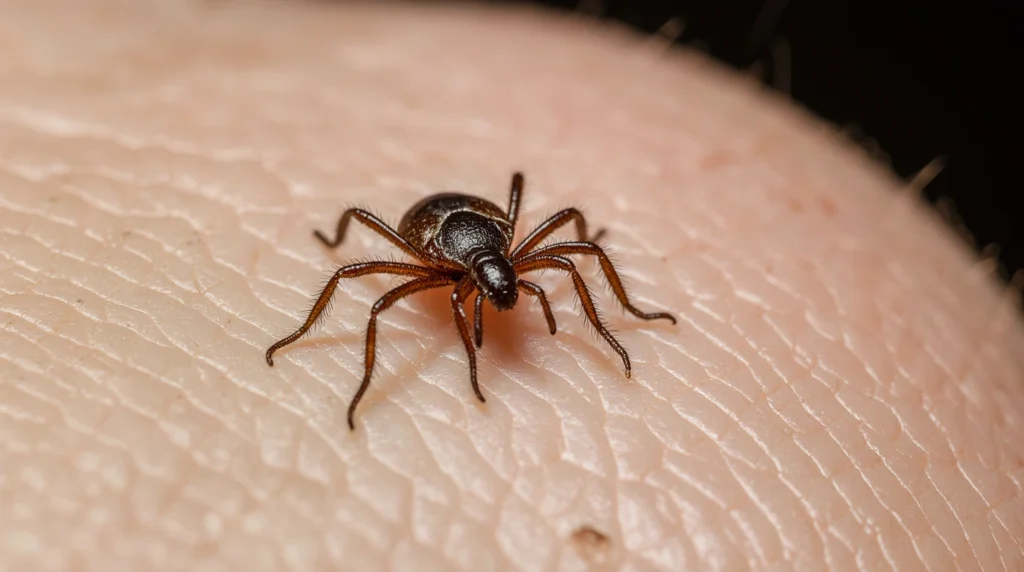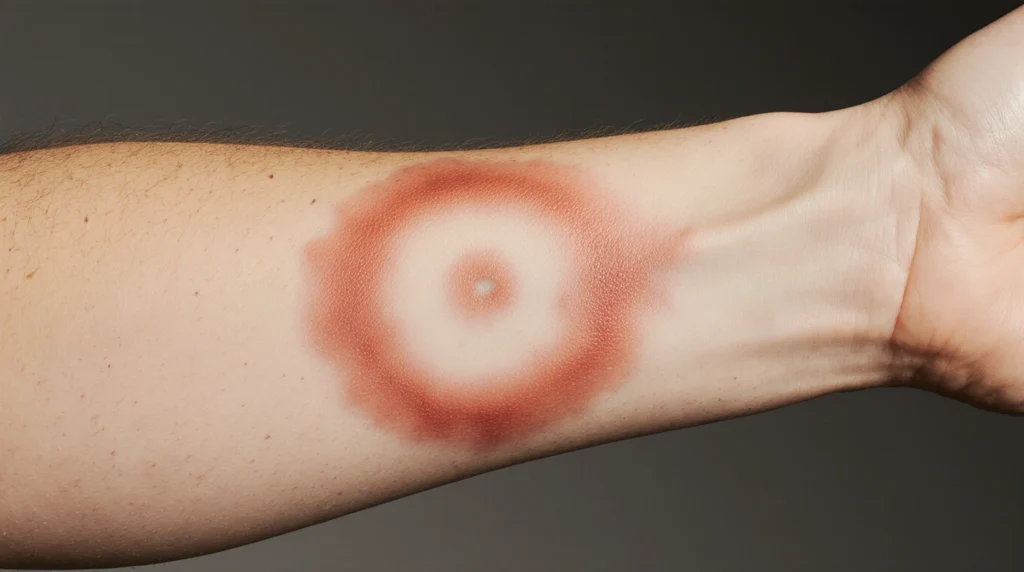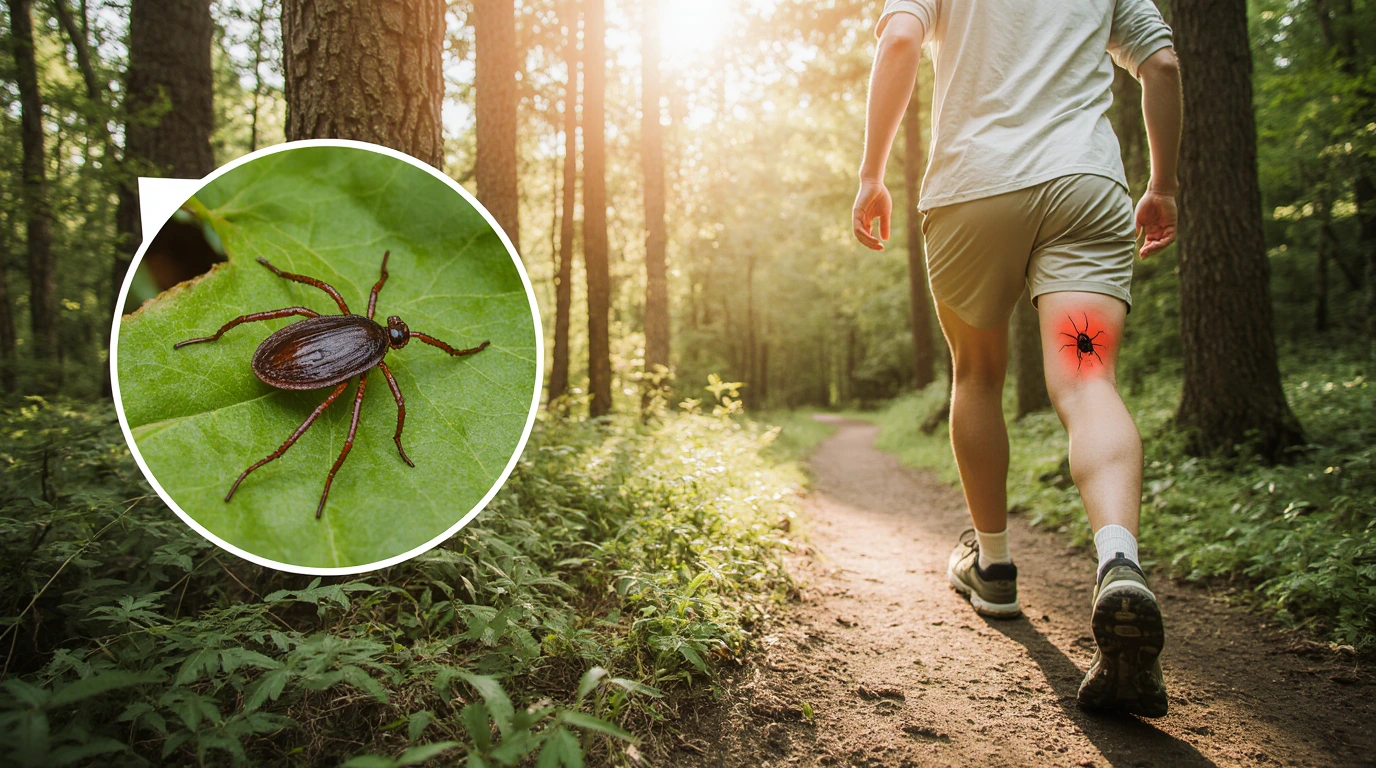Understanding Lyme Disease: Symptoms, Prevention, and Care
When you’re out enjoying nature, you might come across ticks. These tiny creatures can carry Lyme disease. This illness can be very serious and affects many people in the U.S. every year.
If you love spending time outdoors, knowing the symptoms and how to avoid ticks is key. This can help you stay safe from tick bites.
Learning about Lyme disease and its symptoms can help you act fast. This way, you can get medical help quickly and avoid serious problems later.
This article will cover everything you need to know about Lyme disease. We’ll talk about its symptoms, how to prevent it, and what to do if you get it. This will help you stay healthy and safe while enjoying the outdoors.
Table of Contents
What Is Lyme Disease?

Have you heard of Lyme disease? It’s important to know how it starts. Lyme disease is caused by a bacterium called Borrelia burgdorferi. This bacterium is spread to people through bites from infected black-legged ticks.
The Bacterial Culprit: Borrelia Burgdorferi
Borrelia burgdorferi is the bacteria that causes Lyme disease. It has a spiral shape, making it a spirochete. People usually get infected when an infected tick bites them, especially the black-legged tick (Ixodes scapularis). The tick can spit the bacteria into the wound, causing infection.
The presence of Borrelia burgdorferi in ticks is a big worry for public health. It can cause serious health problems if not treated quickly.
History and Prevalence in the United States
Lyme disease was first found in Lyme, Connecticut, in the 1970s. Since then, it has become a big health issue in the United States. It’s most common in the Northeast and Midwest, where the black-legged tick lives.
- The Centers for Disease Control and Prevention (CDC) says Lyme disease is the most common tick-borne illness in the United States.
- The CDC reports about 30,000 Lyme disease cases each year. But, the real number might be higher because some cases are not reported.
How Lyme Disease Is Transmitted

It’s important to know how Lyme disease spreads to prevent it. Lyme disease mainly spreads through the bite of infected black-legged ticks (Ixodes scapularis). These ticks carry the Borrelia burgdorferi bacteria, which causes Lyme disease.
The Life Cycle of Ticks
Ticks go through three stages: larva, nymph, and adult. At each stage, they need a blood meal to move on. The nymph stage is especially risky because nymphs are small and hard to see.
How Ticks Transfer Borrelia Bacteria
When an infected tick bites a person, it injects Borrelia bacteria into their blood. This usually takes a few hours to a few days. Removing the tick quickly can greatly lower the risk of getting Lyme disease.
“The sooner an infected tick is removed, the lower the risk of Lyme disease transmission.”
Geographic Distribution of Lyme Disease in the US
Lyme disease is more common in certain parts of the country. It’s not spread out evenly across the United States. Some areas have a lot more cases than others.
High-Risk Regions
The Northeast and Midwest are hotspots for Lyme disease. States like New York, Massachusetts, Connecticut, Minnesota, and Wisconsin have seen a lot of cases. These places have lots of forests and wildlife, perfect for ticks that carry Lyme disease.
Emerging Areas of Concern
New areas are also seeing more Lyme disease cases. Virginia, Pennsylvania, and New Jersey are now reporting more cases. Even if you don’t live in a high-risk area, it’s still important to know the risk.
| State | Reported Cases | Risk Level |
|---|---|---|
| New York | 10,000+ | High |
| Minnesota | 5,000+ | High |
| Virginia | 1,000+ | Moderate |
Recognizing Lyme Disease Symptoms

Knowing the early signs of Lyme disease is key to effective treatment. Symptoms can vary and range from mild to severe.
Early-Stage Symptoms
Early Lyme disease symptoms can be confused with other illnesses. It’s vital to recognize these signs early to get medical help quickly.
Flu-Like Symptoms
You might feel like you have the flu, with fever, headache, and fatigue. These symptoms can be mild or severe and may come and go.
Skin Manifestations
A distinctive early sign is the erythema migrans rash. This rash grows over time and may be accompanied by other skin issues.
Late-Stage Symptoms
If Lyme disease is not treated, it can progress to its late stage. Symptoms at this stage are more severe and can be debilitating.
Neurological Issues
Neurological problems can occur in the late stage, including meningitis, encephalitis, and Bell’s palsy. These can greatly affect your life quality.
Musculoskeletal Problems
You may also face musculoskeletal issues, like arthritis, joint pain, and muscle weakness. These symptoms can be persistent and hard to manage.
It’s important to know the early and late-stage symptoms of Lyme disease. If you’re experiencing any symptoms, especially after a tick bite, see a doctor.
The Telltale Sign: Understanding the Lyme Disease Rash
The Lyme disease rash, known as erythema migrans, is a key sign for early diagnosis. It often shows up as one of the first signs of Lyme disease. This rash is a vital clue for doctors to start treatment quickly.
Identifying Erythema Migrans
Erythema migrans looks like a growing red area around a tick bite. It can be different sizes and shapes, sometimes looking like a bull’s-eye. But, not all rashes look like this.
Characteristics of Erythema Migrans:
| Feature | Description |
|---|---|
| Appearance | Gradually expanding redness |
| Pattern | Often bull’s-eye, but variable |
| Size | Can range from small to large |
When the Rash Doesn’t Appear
Not everyone with Lyme disease gets the rash. Sometimes, the rash is not there or is hard to see. This makes it harder to diagnose.
Other symptoms like fever, headache, and tiredness might be the only signs. It’s important to know that not having the rash doesn’t mean you don’t have Lyme disease. This can help doctors diagnose and treat earlier.
Diagnosing Lyme Disease
Diagnosing Lyme disease requires a mix of doctor’s evaluation and lab tests. It’s tricky because Lyme’s symptoms can look like other diseases. Getting it right is key for the right treatment.
Blood Tests and Their Limitations
Blood tests are the main way to spot Lyme disease. But, they can miss it early on, leading to false negatives.
Two-Tier Testing Process
The test process has two steps. First, a sensitive test like EIA or IFA checks for Lyme. If it shows something, a Western blot test follows to confirm.
Interpreting Test Results
Understanding Lyme test results is important. A positive test means you’ve been exposed to Borrelia burgdorferi. But, it doesn’t mean you’re infected now. Doctors need to look at your symptoms too.
Other Diagnostic Methods
Doctors also look at your symptoms and medical history. The erythema migrans rash is a big clue. Sometimes, tests like PCR are used, especially for fluid tests.
The CDC says, “Lab tests for Lyme disease aren’t perfect. Doctors mostly rely on symptoms to make a diagnosis.”
- Clinical evaluation is crucial for diagnosing Lyme disease.
- Blood tests are the primary diagnostic tool but have limitations.
- A two-tier testing process is recommended for accurate diagnosis.
Lyme Disease Treatment Options
Effective Lyme disease treatment needs a mix of antibiotics and managing symptoms. Early diagnosis is key to successful treatment and avoiding complications.
Antibiotic Treatments
Antibiotics are the main treatment for Lyme disease. The choice and length of treatment depend on the infection’s stage and severity.
Early-Stage Treatment
In the early stages, oral antibiotics like doxycycline or amoxicillin are used for 2 to 4 weeks. Early treatment greatly improves outcomes.
Late-Stage Treatment
For advanced cases, intravenous antibiotics may be given for up to 4 weeks. This is for patients with severe symptoms or neurological issues.
Managing Symptoms
Managing symptoms is also vital for recovery. This includes pain medication and physical therapy for joint pain and stiffness.
Alternative and Complementary Approaches
Some patients try alternative therapies like herbal supplements or acupuncture. But, it’s important to talk to a healthcare provider before starting these treatments.
Combining conventional treatments with supportive care and alternative therapies helps manage Lyme disease. This approach improves patients’ quality of life.
Preventing Tick Bites

Learning how to prevent tick bites is key to avoiding Lyme disease. It’s important to take steps to protect yourself when outdoors, especially in tick-prone areas.
Protective Clothing and Repellents
Wearing the right clothes and using repellents is vital for tick prevention. EPA-approved repellents with DEET, picaridin, or oil of lemon eucalyptus work well against ticks.
EPA-Approved Repellents
Make sure the repellent you choose is EPA-approved. This means it’s been tested for safety and effectiveness. Always use it as directed.
Proper Attire for Outdoor Activities
Wear long-sleeved shirts, long pants, and closed-toe shoes to lower tick exposure. Tucking pant legs into socks can also help keep ticks away from your legs.
Tick Checks and Proper Removal
It’s crucial to check for ticks after being outdoors. Knowing how to safely remove attached ticks is also important.
How to Perform a Thorough Tick Check
Do tick checks on yourself, kids, and pets after being outside. Focus on areas like the armpits, groin, and behind the knees.
Safe Tick Removal Techniques
To remove a tick, use fine-tipped tweezers to grab it as close to your skin as you can. Pull upward slowly and steadily. Don’t twist or jerk the tick.
By wearing protective clothing, using repellents, and doing regular tick checks, you can lower your risk of tick bites and Lyme disease.
Lyme Disease Prevention in Your Environment
Lyme disease prevention starts in your own backyard. Creating a safe outdoor space requires attention to detail. It also needs a proactive approach to reducing tick habitats.
Yard Maintenance Strategies
Effective yard maintenance is key to preventing Lyme disease. Start by keeping your grass short. Remove leaf litter, as ticks thrive in moist, shaded areas.
Clearing weeds and debris around your yard and gardens can also help. This reduces tick habitats.
Consider creating a tick-free zone by using wood chips or gravel. This barrier can help prevent ticks from migrating into your yard.
Pet Protection Measures
Pet protection is another crucial aspect of Lyme disease prevention. Regularly check your pets for ticks. Use tick preventatives as recommended by your veterinarian.
Keeping your pets out of heavily wooded areas can also reduce their risk. By combining yard maintenance strategies with pet protection measures, you can significantly reduce the risk of Lyme disease in your environment.
Complications of Untreated Lyme Disease
If left untreated, Lyme disease can cause serious health problems. It’s a bacterial infection from Borrelia burgdorferi, spread by black-legged ticks. Early treatment usually fixes the problem, but ignoring it can lead to big health issues.
Neurological Complications
Neurological problems can happen if Lyme disease isn’t treated fast. These include meningitis, encephalitis, and Bell’s palsy. Quick treatment is key to avoid these serious brain issues.
Cardiac Issues
Lyme disease can harm the heart, causing irregular heartbeat or palpitations. In severe cases, it can cause serious heart problems.
Arthritis and Joint Problems
Untreated Lyme disease can cause arthritis and joint pain, known as Lyme arthritis. This can make moving hard and cause a lot of pain. Early treatment can greatly lower the chance of these joint problems.
A doctor said, “Early diagnosis and treatment are very important. They greatly reduce the risk of these complications.”
Special Considerations for At-Risk Groups
It’s important to understand how Lyme disease affects certain groups. This includes children and pregnant women, who face special challenges.
Lyme Disease in Children
Children are more likely to get Lyme disease because they spend a lot of time outside. Symptoms in kids are similar to those in adults, like fever and headache. But kids might not be able to tell you how they feel, making it harder to diagnose.
Parents and caregivers need to watch for ticks and get medical help if they see any symptoms.
Pregnancy and Lyme Disease
Lyme disease can be risky for both mom and baby during pregnancy. Getting treatment quickly is key to avoid problems. Even though there’s a risk of passing it to the fetus, the right antibiotics can lower this risk a lot.
Pregnant women in areas where ticks are common should be extra careful. They should talk to their doctor if they think they’ve been bitten or infected.
Conclusion

Understanding Lyme disease is key to preventing and caring for it. Lyme disease is caused by a bacterium called Borrelia burgdorferi. It spreads through tick bites. Knowing the symptoms is important for early treatment.
The symptoms can range from a distinctive rash to serious neurological and cardiac issues. A summary on Lyme disease shows the need for prevention. This includes wearing protective clothing, using repellents, and checking for ticks regularly.
By doing these things, you can lower your risk of getting Lyme disease. If you do get it, antibiotics can help. Managing your symptoms is also important for getting better.
Prevention and care go hand in hand. Preventing tick bites is the best way to avoid Lyme disease. Being mindful of your surroundings and keeping your yard clean helps. Protecting your pets is also important.
This approach helps you stay safe and healthy. It gives you the power to protect your own health.







